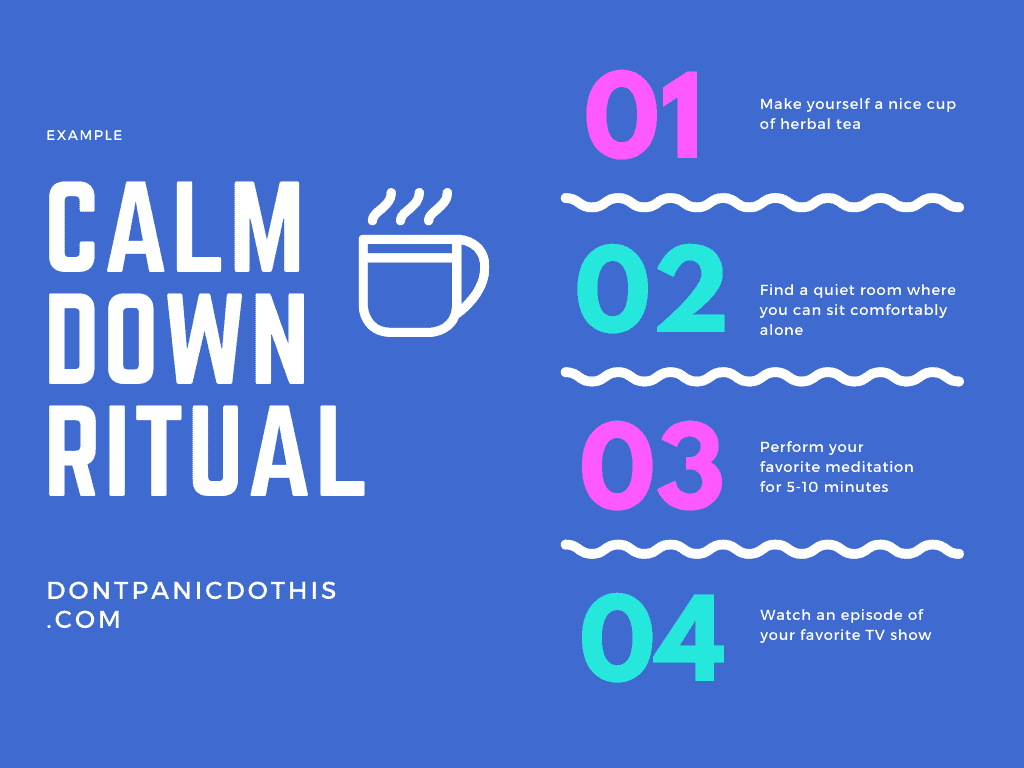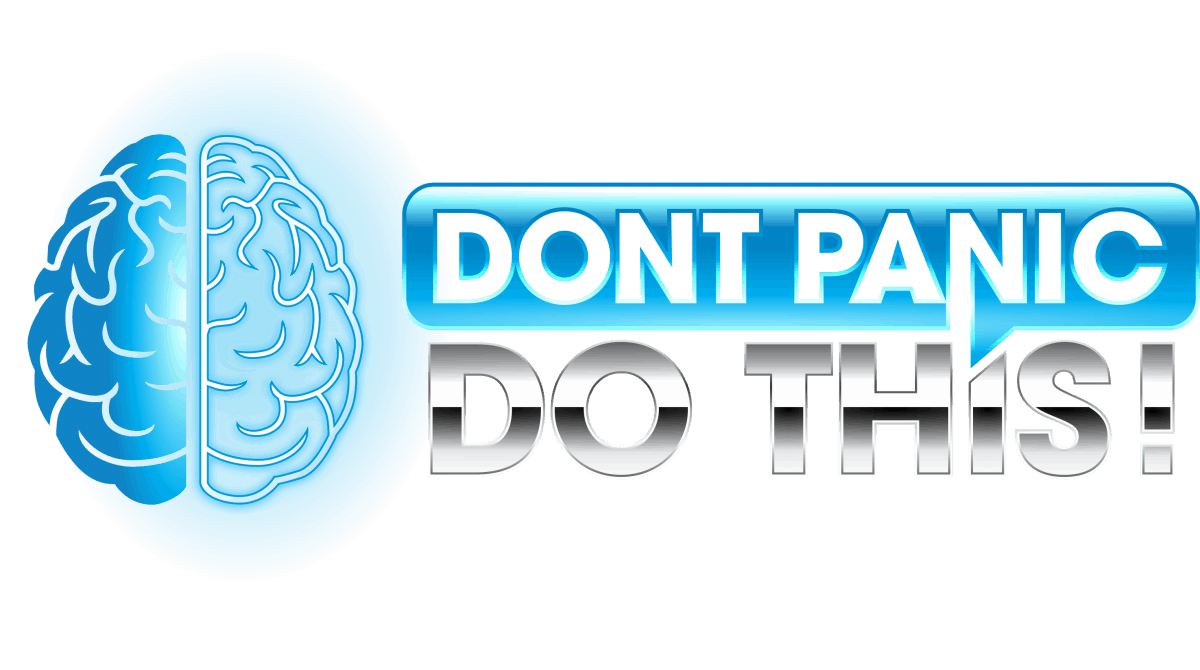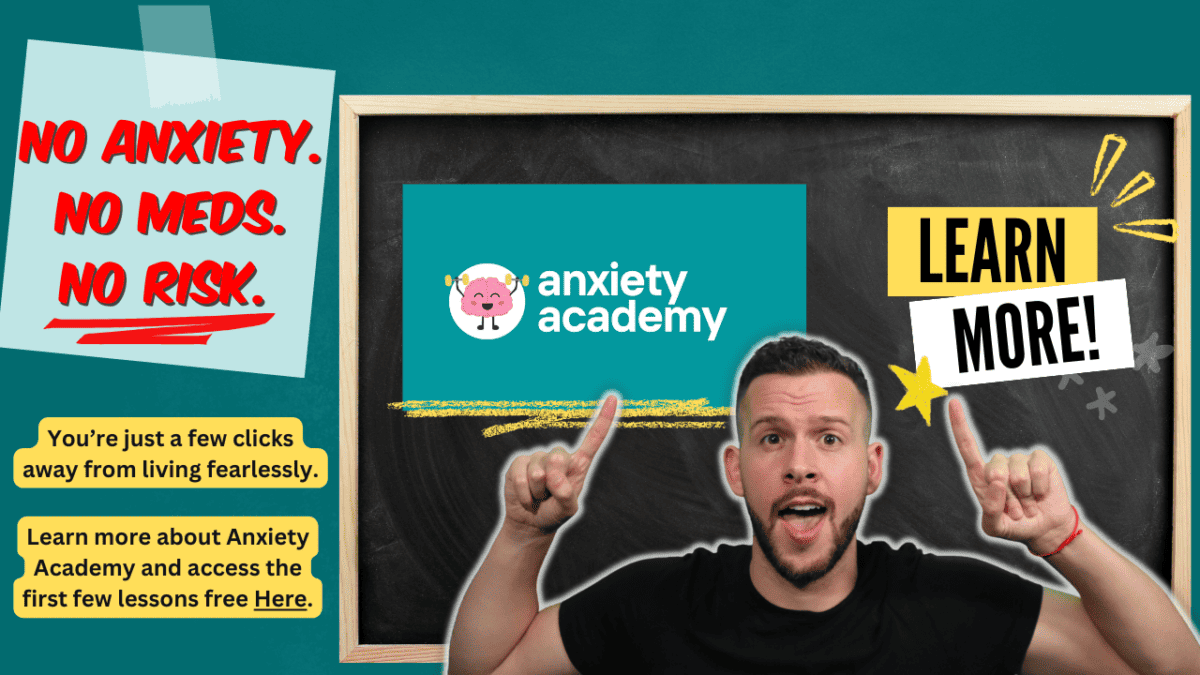When your panic attack finally ends, you may be left with more questions than answers. Post panic attack recovery is an important step in getting you back to normal and preventing future panic attacks. For this reason, you’ll probably be wondering… What should I do after a panic attack?
After a panic attack you may feel a bit tired or burnt out. Try switching to a new environment while you continue to calm down. Relax with a cup of herbal tea or utilize your own “calm down ritual” if you have one. This post panic attack recovery period is a good time to reflect on your experience and try to see it in a positive light.
If terms like “calm down ritual” and “seeing your experience in a positive light” seem foreign to you right now, no worries.
Read on and I’ll elaborate with the most complete guide to post panic attack recovery out there. By the end, you’ll know exactly what to do after a panic attack.
Let’s get right into it!
The Complete Post Panic Attack Recovery Guide:
1. Understand What a Panic Attack IS
Okay, so… what the heck was that?!
If this was your first panic attack, you’re probably in a world of confusion right now.
If you’ve had panic attacks before and are more than familiar with them, feel free to just hop over to the next section if a brief explanation of panic attacks doesn’t interest you.
The first time I had a panic attack, I quite literally thought that I was having a heart attack (this was in early high school, by the way!). I laid on my couch hyperventilating, convinced I was going to die. I had never even heard of a panic attack before, so naturally my mind jumped to the worst conclusions and made the experience much worse than it had to be.
A panic attack is basically a relatively short, but extremely intense burst of anxiety. Most panic attacks only last a few minutes, but during those 3-10 minutes (typically) you can literally feel like you are going to die, or as though you desperately need to escape your current situation or environment. It’s probably one of the worst feelings a person can experience.
Panic attacks can occur (seemingly) randomly as a result of stress and other factors, or they may occur as a direct response to a triggering stimulus like a phobia.
If you haven’t already, consider reading our articles on panic disorder and on why we experience anxiety to better understand panic attacks and why they occur.
For help with a panic attack that has not already ended, definitely check out our article on how to stop a panic attack before going forward.

2. Embrace the “Rest and Digest” Response
Now that your panic attack has ended, you can allow yourself to relax a bit.
While beginning your post panic attack recovery, you can rest at ease with the knowledge that you’ve burnt off all that extra “bad energy” for now. What this means is that you should, most likely, be good for a while without additional panic attacks. This is not always a 100% guarantee, but it always seemed to be the case with my own panic attacks.
Panic attacks burn a tremendous amount of energy. Our minds are racing, our heart is pounding, our blood is pumping, and our lungs are working overtime during an anxiety attack. Frankly, for a few minutes, it can feel as though our body is working as hard during a panic attack as it is while running a marathon! This all occurs while our brain is in its “fight or flight” phase.
The good news is, eventually our body’s fight or flight response gets tired. Our brain realizes that we are not, in fact, in any real danger, and we are simply wasting energy on a panic attack. Our parasympathetic nervous system then takes control as we switch into “rest and digest” mode.
Our body has burnt a ton of energy, and now we can relax a bit. After a panic attack we often feel tired or fatigued, but this at least makes it less likely for us to have another panic attack any time soon. This is just something to keep in mind and to help you relax after a panic attack. Recognize, and even visualize all of the excess “nervous” energy you’ve just burnt off.
Take a deep breath and relax, you’re through the panic attack and should feel calm for a while.
3. Change Your Scenery
With the chaos of your panic attack freshly behind you, you might benefit from a change of scenery. If you were outdoors when your panic attack occurred, perhaps going inside and relaxing on the couch would be a good idea. If your panic attack occurred inside, maybe you’d like to talk a brief walk outside and enjoy some fresh air.
Additionally, consider changing up your social environment. If your panic attack had occurred in a social setting, maybe you could use some alone time. Or, if your panic attack came on while you were alone, you might find it helpful to reach out and talk to a friend for a bit.
Whatever your environment was when your panic attack began, changing it could be a helpful way for you to leave your anxiety behind as you transition into a better headspace.
4. Establish a “Calm Down Ritual” for Post Panic Attack Recovery
One of the best things you can do after a panic attack for your post panic attack recovery is to establish what I call a “calm down ritual.” Simply put, this is a series of actions you can perform any time you are actively trying to relax or calm yourself down. These actions can be calming in and of themselves, or they can be actions that your brain learns to associate with calming down over time through habitual repetition.
Your calm down ritual is going to be unique to yourself, but you can start to build one by including any action that you already find to be relaxing. One easy example of this would be to make yourself a nice, relaxing cup of herbal tea containing naturally relaxing ingredients like chamomile or passionflower (click here for my full article on herbal tea recommendations for anxiety).
Here’s one example of what a calm down ritual might look like:
- Make yourself a nice cup of herbal tea
- Find a quiet room where you can sit comfortably alone
- Perform your favorite meditation for 5-10 minutes
- Watch an episode of your favorite TV show
Here’s an example of a slightly more active calm down ritual:
- Play your “Conquer Anxiety” playlist on your phone
- Go for short walk around the block
- Come home and practice light yoga for 5 minutes
- Call a trusted friend for a brief conversation
These are completely hypothetical examples of calm down rituals that I just made up on the spot, but I think you get the idea. Post panic attack recovery is going to vary greatly from person to person, as each individual will find different stimuli to be relaxing.
It’s also important to point out that, when I say “calm down ritual,” I do not mean that you need to be lulling yourself to sleep. You can still be active, and even exercising during your calm down ritual; the point is that you are actively calming your mental state as opposed to allowing panic and anxiety to run rampant.
Your calm down ritual may include mild supplementation like drinking an herbal tea, and it may include practiced coping mechanisms such as meditation or yoga which can be practiced in your free time. Activities like these should help to actively decrease anxiety in people across the board almost immediately, without the brain even having to learn to associate the actions with a state of relaxation.
As a bonus, any neutral stimuli that becomes a normal part of your calm down ritual may eventually gain the ability to relax your brain on its own. For example, perhaps there is a certain armchair in the couch that you sit in every time you are relaxing with a cup of tea during your calm down ritual. Over time, your brain will learn to associate that armchair with the state of relaxation. Eventually, just sitting in that armchair will be able to help you relax.
Experiment a bit and see what works for you, but a calm down ritual should become an integral part of your post panic attack recovery, as it will serve as a powerful coping mechanism to quickly stop panic attacks in the future.

5. Enjoy Your Favorite Snack or Drink
This step could be considered a part of your calm down ritual, but I consider it worthy of its own brief section. After a panic attack, you’ll most likely have burned off a considerable amount of energy, and may be feeling fatigued as a result.
At this point, it might be a good idea for you to have something to eat or drink to help you recover a bit and replenish that energy. Food that is good for anxiety reduction is ideal here if possible, as opposed to anything overly sugary or unhealthy.
In addition to replenishing your energy, eating allows the brain to release “feel good” chemicals called endorphins which can help to boost your mood a bit during your post panic attack recovery.
6. Investigate What Caused Your Panic Attack
By this point you should be feeling good and calm. Your panic attack is well behind you by now, but your job is not over yet. We don’t want this event to go to waste as a negative experience. Instead, we want to investigate a bit to better understand our mental health, our anxiety, and our panic attacks.
Take a few moments to think back to your panic attack and try to figure out what may have caused it. Sometimes this will be obvious, as a specific phobia or fear can cause a high enough level of anxiety to evoke a panic attack. Other times, a panic attack could occur due to more subtle causes, such as pent-up stress that’s built over time, or the sudden hyper-awareness of one’s own autonomous bodily functions.
Experts often suggest that people examine HALT factors when considering any irregular or less than ideal mental states. This is whether you are feeling:
H – Hungry
A – Angry
L – Lonely
T – Tired
If you are feeling hungry, angry, lonely, or tired, sometimes this could be cause for the sort of stress that can build up into a panic attack. In this case, you may just need to address that primary concern.
If there is a specific fear or phobia that caused your panic attack, or if your fear of panic attacks themselves (panic disorder) has caused them, it’s very helpful to be aware of it. This will make things easier later on when we address our anxiety head-on through exposure therapy.
7. Journal Your Experience
Now that your panic attack is over, I want you to write down how you feel about the whole experience. The more detail the better.
Write down what caused your panic attack, which coping mechanisms helped to stop your panic attack, and which post panic attack recovery strategies were most helpful for you. This may feel silly or tedious at first, but it is going to come in handy for you with future panic attacks.
You can choose to write in a physical journal, or you can just jot a few notes down somewhere on your phone. Ideally, you’ll set dates and times next to your panic attack event and any future panic attacks that occur.
The reason I consider this step to be so important is because of how logically we tend to think after a panic attack. During a panic attack, we seemingly lose all control of the logical parts of our brain and give in entirely to our emotions. Yet, once the panic attack subsides, logic returns and we tend to feel a bit silly about having lost control in the first place.
By journaling how you feeling during and after your panic attack, you’ll be able to return to those logical realizations at any time. Eventually, you’ll get to a point where the pattern is familiar to you and the very idea of having a panic attack just feels silly and illogical.
8. Recognize These Facts
There are a few facts that I always recommend panic attack sufferers to remind themselves of.
These facts are:
- Panic attacks are extremely temporary
- Panic attacks are completely harmless
If you’re journaling your experience, these are just two more feelings to take note of.
During a panic attack, our thoughts become entirely illogical. We feel as though the panic attack will last forever, as if we’ll be having panic attacks our whole lives, or as though we are going to die from our panic attack.
Yet, every single panic attack ends the same way:
In a few minutes, our anxiety attack passes and we are no worse for wear.
Most panic attacks last no more than a few minutes. Even a “long” panic attack is usually over in less than 10 minutes. While it may feel like a lifetime, the fact is that every panic attack is going to be quite limited in duration: Even on our scariest day, our body simply doesn’t have the energy to carry on a panic attack for very long.
Take solace in this fact, and be aware of how temporary panic attacks really are. Better yet, set a timer on your watch or phone and see exactly how long your panic attack lasts. Next time, you can refer to this time in your journal and simply watch the clock, knowing that – no matter how bad it may seem – your panic attack will not carry on for too long.
Similarly, take note of how little harm your panic attack actually caused you. Sure, it was quite scary. But did you die? Of course not, you’re no worse for wear, and remembering this will help you to better face any future panic attacks.



